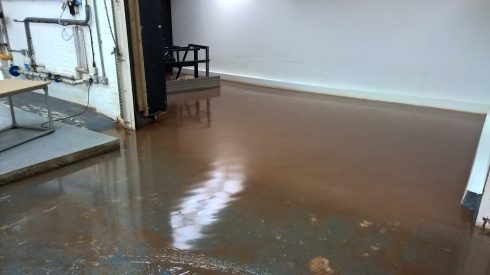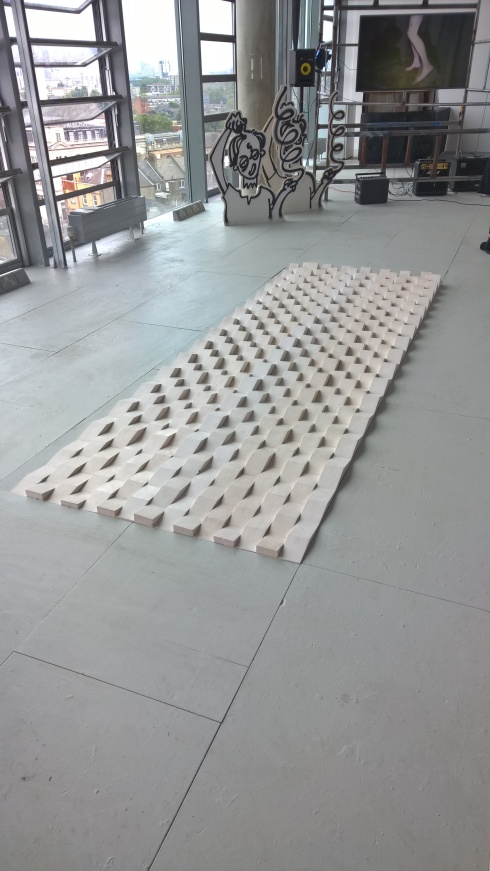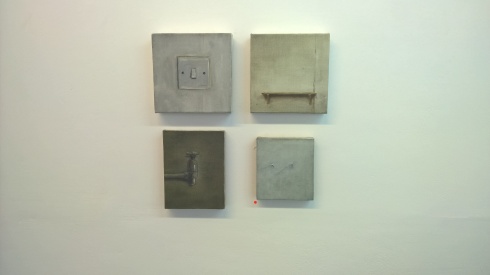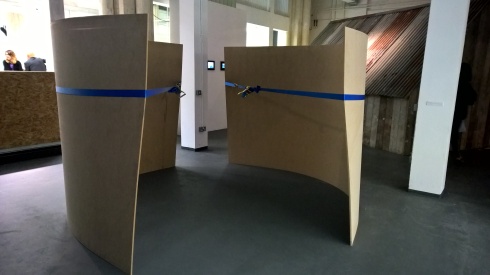Whilst graduates of Central St Martins Jessica Windhorst and Hanping Feng depicted domestic interiors, as did Zsofia Schweger at the Slade School of Fine Art, it seems that a number of graduating students have turned their attention to the environment in which they work: the studio.
Alexander Duncan has observed the sloping end of the sculpture studio at the Royal College of Art, and by flooding it and making a wave machine that creates a tide that laps upon the shoreline of the rest of the studio has made this visible.
Here the water flows like in Pamela Rosenkranz’s installation in Switzerland’s Pavilion at the 2015 Venice Biennale, whilst a student at Wimbledon College of Arts used water to visualise sound waves in a self perpetuating sound installation with drums and speakers. Flow is also a psychological term which Wikipedia, (accessed 22/07/2015) says “… is the mental state of operation in which a person performing an activity is fully immersed in a feeling of energized focus, full involvement, and enjoyment in the process of the activity. In essence, flow is characterized by complete absorption in what one does.” Hence Duncan is absorbed in his studio.
Joseph Winter installed a series of rows of spikes inserted into the studio floor at the Goldsmiths BA show like the spikes placed in spaces such as under flyovers to prevent anti-social behaviour. There has been a recent campaign (written about in the London Evening Standard) against the installation of these outside Tesco in Regent St and Foxtons, dubbing them ‘homeless spikes’ and this installation is as if the college had installed them to discourage graduated students from entering the studios like Paternoster Square was closed in 2011 to prevent Occupy London taking up residence.
In its cast plaster form this also seems to relate to Sarah Blum’s installation in the BA Fine Art and History of Art show at Goldsmiths of casts which must be closely inspired by Constantin Brancusi’s Endless Columns, although apparently come to by casting glasses in the manner of Rachel Whiteread and then enlarging the form.
Daniel Buren (The Function of the Studio. 1971) says that “By disposing of a large part of his work with the stipulation that it be preserved in the studio where it was produced, Brancusi… afforded every visitor the same perspective as himself at the moment of creation. He is the only artist who, in order to preserve the relationship between the work and its place of production, dared to present his work in the very place where it first saw light, thereby short-circuiting the museum’s desire to classify, to embellish and to select.” Hence we should consider the fact that all these graduates present their work in the studio, albeit perhaps a sanitised version thereof, as a debunking of the museum. Albrecht Barthel (Brancusi’s Studio: A Critique of the Modern Period. 2006. In Hoffmann, J. ed. The Studio. 2012:131) confirms that sculptor François Lalanne argued that “the studio in situ… retain[s] its raison d’être, not to be fossilized in a museum and preserved ad infinitum.” On that note perhaps I am starting to fossilise these works by writing about them.
Buren (op. cit.) opens setting out the function of the studio as:
1) It is the place where the work originates.
2)It is generally a private place, an ivory tower perhaps.
3) It is a stationary place where portable objects are produced.
By planning the opening of the studios to the public gaze the work is often created specifically for its environment, as I would argue that Winter’s is.
Matt Morris in the Slade MA show has painted just about every possible tool that might be found in the studio. These and, particularly, the accompanying cabinet of clay models, speak of being a museological collection, classified, divided and displayed. With a sense of immediacy this series demonstrates an interest in process and production. Mierle Laderman Ukeles wrote in her 1969 Maintenance Art Manifesto (In Stiles, K. ed. Theories and Documents of Contemporary Art. 1996:623) that “Everything I say is art is art. Everything I do is art is art.” [sic]. However Kristine Stiles (Process. In ibid, 582) says that although Mark Thompson’s work was structurally formed by attention to processes, “he asserted that process alone was not enough to sustain the production of art, but needed to be integrated into the resultant formal structure of a work of art.” Hence whilst the process of working with tools might be considered art, by transferring that process into painting Morris has built more of a practice with substance, objectifying process.
Meanwhile Phil Amy at the Wimbledon College of Arts BA show has painted a shelf, light switch, tap and two pins left in a wall that must have previously supported an artwork. We are left with the aftermath of a studio, vacated upon conclusion of the course.
Both these artists seem to have succumbed to boredom and taken to looking around the studio for inspiration. Lars Svendsen (A Philosophy of Boredom 2006:33) writes “Boredom is connected to reflection… Reflection decreases via diversions… Work is often less boring than diversions, but the person who advocates work as a cure for boredom is confusing a temporary removal of the symptoms with curing a disease.” We might analyse that these artists use their studios as a diversion to boredom, creating a programme of work around them, but that these are not sustainable practices in the long term.
Emilie Peyre Smith in the Goldsmiths BA show has demonstrated an interest in the construction and materials of the studio/exhibition space, P.S. Standing Pair consisting of a pair of 12’x6′ sheets of MDF, which have been contorted by ratchet straps, suggestive of interest in the shipping and transportation of art. In essence Smith has transformed a two-dimensional plane into a three-dimensional object. There is a performative aspect to this piece as there is the potential energy built into it that one day the ratchet straps could break and the boards spring back to being flat.
More importantly, however, by the way this affects the viewer’s vision of and movement through the space Smith references Richard Serra’s Tilted Arc and the discussions and controversy surrounding it. Serra wrote (Letter to Donald Thalacker, 1985. In Kwon, M. One Place After Another, 1997. In Kocur, Z. ed. Theory in Contemporary Art since 1985, 2005:33) that Tilted Arc was a site-specific work and not to be relocated. He elaborated in 1989 (Tilted Arc Destroyed. In Kwon, M. op. cit.) that:
Site-Specific works deal with the environmental components of given places. The scale, size, and location of site-specific works are determined by the topography of the site, whether it be urban or landscape or architectural enclosure.
We are dealing with the architectural enclosure of the studio space. Extracted from this (to a larger environment) Smith’s work would not impact upon the viewer to as great an extent, Winter’s work may be viewed on purely aesthetic grounds and Phil Amy’s paintings may be viewed as domestic objects.



























